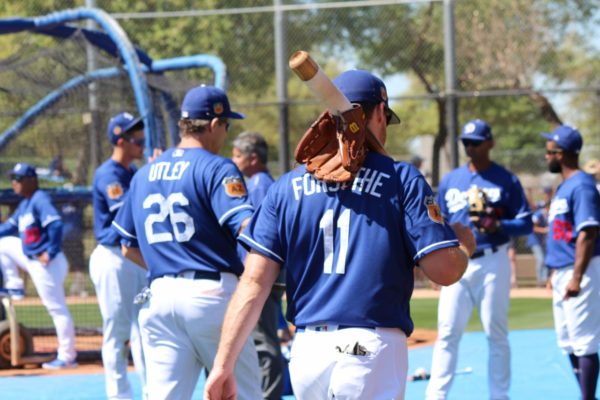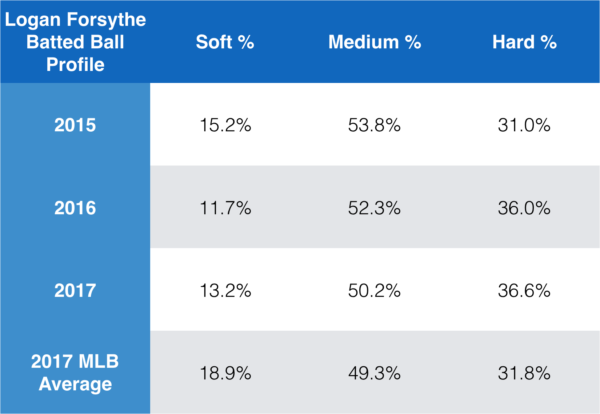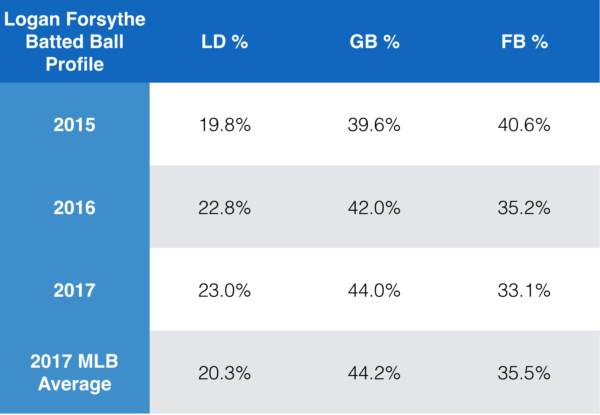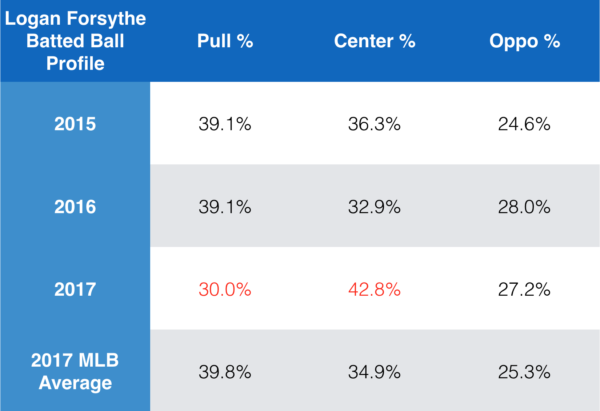
2017 was a disappointing first year with the Dodgers for Logan Forsythe, but 2018 may give us reason to be hopeful for more.
This offseason, the Dodgers exercised the option to retain Forsythe for his final year at $8.5 million. He will be a free agent after the season. They acquired him last year before the season started, in a one-for-one swap, sending top 50 overall prospect José De León to Tampa Bay. De León only threw 41 innings overall last year, with 38 of those in AAA, as he dealt with a flexor strain and tendonitis. Unfortunately, word just came out that he is going to need Tommy John surgery. That’s too bad, I like the kid and hope he recovers well. Their top prospect Brent Honeywell is also out with TJ surgery. Yeesh. Just a reminder to trade your pitching prospects.
A reminder on the Forsythe the Dodgers traded for
In his last two years with Tampa Bay, Forsythe put up his best seasons to date. In almost 1,200 plate appearances (PA), he posted a .273/.347/.444 slashline, accumulating 6.7 fWAR, with a .343 wOBA and a 119 wRC+, which ranked seventh among all second baseman over that stretch.
In 2,100 defensive innings, Forsythe put up a -1.0 Ultimate Zone Rating/150 games played (UZR/150) over that stretch, which was good for 12th among second baseman. However, he was fifth in Defensive Runs Saved (DRS) over that same stretch with nine behind Gold Glovers like Dustin Pedroia, Ian Kinsler, and Dee Gordon.
Forsythe in 2017
The 30 year-old had a hot start, but dealt with two successive injuries early into his season. He broke his right big toe when he was hit by a pitch in the dirt on April 18, just three weeks into his season.
#Dodgers mgr Dave Roberts said Forsythe injury is "not a 4 to 6 week thing" but probably at least a couple weeks
— Bill Plunkett (@billplunkettocr) April 19, 2017
Initially, he was expected to miss two weeks, but because of a hamstring/groin issue, he was out for a total of five weeks.
In a disappointing year, he hit .224/.351/.327 with a .307 wOBA and 90 wRC+. This was a significant drop off from his last two years, with his power diminishing to a .102 ISO, down from .163 and .180 the previous two years, and only six home runs after coming off years with 17 and 20. However, in the postseason, Forsythe was great. In 46 PA, he hit .297/.435/.351 with a .337 wOBA, and 110 wRC+.
His 2017 defense
After averaging -1.0 UZR/150 (slightly above average for 2B) over his last two seasons, he saw that jump to 9.2/150 in 2017. He also ranked seventh in DRS over that same period with nine. That ranked fourth among second baseman, trailing only Yolmer Sanchez, Pedroia, and Ozzie Albies.
He also played 301.2 innings at third while Turner was out, and had a 20.1 UZR/150 while he was there. With a minimum of 300 innings played at third, that ranked as the highest UZR/150 in the league. He accumulated a DRS of four while at third, the 14th best number in the league even though many ahead of him had over 1,000 innings at the spot.
Forsythe had his best defensive season as a pro in 2017.
His 2017 offense — What happened to his bat?
Chad wrote this back in July about Forsythe’s lack of aggression and difficult acclimation.
Actually, Forsythe is the most passive hitter in the majors (minimum 150 PA), swinging at just 32.1% of pitches. Perhaps even more telling is that he swings the second-least amount (J.J. Hardy, 50.0%) in the majors at pitches in the strike zone at just 50.5%. Forsythe has always been a selective hitter, but this is noticeably different than his career 40.0% swing rate and 59.1% swing rate at strikes.
Not much changed after that, and in 2017, he was the most passive hitter in baseball. He swung just 32.5% of the time, the least in baseball. Ranking near him were guys like Matt Carpenter (34.1), Mookie Betts (36), and Mike Trout (37.7). These guys all had very high on-base percentages. It varies, depending on how you’re pitched, but not swinging a ton is a valid approach. However, Forsythe also swung the fewest at pitches in the zone (51.2%), and most of the guys who don’t swing an awful lot take advantage of pitches that are in the zone. For contrast, Freddie Freeman led the league at zone swing percentage at 84.2%. Forsythe was also second in swinging at pitches outside the zone at a measly 16.2% behind only Joey Votto. Essentially he just absolutely never swung. The best hitters don’t swing at pitches outside of the zone, and they capitalize on the pitches in the zone. Forsythe mastered the former in 2017, but he needs to get back to attacking pitches in the zone.
From 2015-16, in his last two years with Tampa, he had a walk rate of 8.5% with a strikeout rate of 20.1% — nearly identical to Corey Seager (8.5 BB% and 19 K%) over the same stretch. Essentially, he was slightly above average at both metrics. However, in 2017, Forsythe’s BB% shot up from 8.5% to 15.7%, but his K% also increased to 24.8%.
Why was 2017 an outlier?
When the Dodgers acquired him, Forsythe was coming off the best two years of his career. It’s important to consider that this was Forsythe’s first year facing a majority of these pitchers, and for a non-elite hitter, an adjustment period is a normal expectation.
If you look at Forsythe’s first and second half splits it looks like there is little reason to be optimistic.
1st Half – (.249/.369/.345) .323 wOBA, 100 wRC+, .342 BABIP
2nd Half – (.201/.333/.310) .292 wOBA, 80 wRC+, .260 BABIP
However, I think these splits are slightly misleading. I found it more reasonable to identify his season in three parts.
4/3 To 4/18 (54 PA) – The first two or three weeks of the season, Forsythe was off to a strong start with a .295/.407/.341 triple slash, with a .341 wOBA, and 113 wRC+, he was just lacking some power (.045 ISO).
5/23 To 6/27 (118 PA) – Forsythe returned to action from injury on May 23 and struggled over the next five weeks. I think it’s extremely important to note that less than two weeks after he returned, he was removed from a game with a hip/groin issue (likely something lingering from his initial injury that was acting up). I doubt he wanted to start his tenure with 50+ games missed so I think it’s reasonable to assume he played at less than 100%. A ton of guys do it — it’s hard to be 100% for 162 games.
Logan Forsythe getting a day off because right groin/hip issue. Roberts hopeful he can start tomorrow. #Dodgers
— David Vassegh (@THEREAL_DV) June 3, 2017
Over this stretch he hit .163/.297/.255 with a .258 wOBA and 58 wRC+.
6/28 To 10/1 (267 PA) – The largest of the three sample sizes, he slashed .237/.363/.356 with a .321 wOBA and 99 wRC+. In my opinion, this was much more in-line with his ability. He was still lacking power, and hits overall, but the OBP was great and he was a relatively average bat.
Then obviously in the postseason, Forsythe was great, and in 46 PA hit .297/.435/.351 with a .337 wOBA, and 110 wRC+.
What does this mean?
Logan had two notable awful stretches. One was a five-week stretch after returning from injury, where he left a game two weeks into his return for the same thing that kept him on the DL. Odds are he was rusty from missing so much time and it looked like his injury was still nagging. After returning, Forsythe said to Bill Plunkett of the Orange County Register:
“It’s unfortunate when you go down and you kind of feel like you’re finding your swing and you’re finding the groove of things,” he said. “But it’s a long season. That feeling will come back.”
Over this stretch in 118 PA, he hit .163/.297/.255 with a .258 wOBA and 58 wRC+.
You’ll remember the other bad stretch. The Dodgers very infamously went 5-20 in a 25 game stretch from August 26 through September 20. They got swept by the Diamondbacks twice over that stretch, and supposedly had no chance at getting past them in the playoffs, or making it to the World Series. Welp.
Over that losing stretch, as a team they slashed .205/.287/.352 for an OPS of .640. As far as Forsythe went, he had his BB and K rates stay pretty in-line with the rest of the season, 14.7% and 20.6%, but ran a slash of .123/.265/.211 with a wOBA of .223 and a wRC+ of 35, with a BABIP of .143 (!!!). Forsythe was really bad, but so were other key contributors to the offense. Nobody could hit the ball at this point in the season, and it felt like the sky was falling.
Basically, outside of these two bad stretches, Forsythe had 253 PA (nearly half a season) over which he slashed .282/.399/.393 for an OPS of .792. In his last two years with Tampa Bay where he was a three to four win guy, he averaged .273/.347/.444 for an OPS of .791. I understand how that could be considered as nitpicking — removing the bad sections from a season. However, I think both of those stretches were not indicative of his true talent level, primarily due to injury.

Last year, Forsythe hit the ball hard as frequently as ever, and was better than league average in every category. Keep in mind that 2015 was his best offensive season, and he made contact with the ball as well as if not better than he did in that season.
FanGraphs quality of contact resource page lists excellent quality of contact at roughly 15% soft, 45% medium, and 40% hard contact (Marcell Ozuna ran a 18/43/39 on a very successful offensive year). Forsythe made less soft contact, more medium contact, and slightly less hard contact than a star like Ozuna. So what gives?
If we look at that stretch during the losing streak for Forsythe again, he had a BABIP of .143. Over that stretch during the losing streak, Forsythe had a 16%/40%/44% contact split. He traded some line drives for fly balls during this stretch, but that BABIP was still absurdly low for his quality of contact. He was hitting the ball harder than he did all season during that stretch. That seems accurate of how every game felt during that losing streak.

Forsythe in 2017 hit more line drives and ground balls than ever, and significantly less fly balls than normal. You would expect a similar BABIP to his previous years, or even a slight improvement. Yet while Forsythe had a .323 BABIP in 2015 followed by a .314 BABIP in 2016, in 2017, with an improvement in peripherals that would increase his BABIP, his BABIP dropped to .299. We know he was hitting the ball hard, and hit the ball at launch angles that would be likely to produce more hits and a higher batting average more often, and yet saw a drop off on his BABIP.

Note: All data obtained from FanGraphs.
Here, the big outliers are in red.
In 2017, he pulled the ball at the lowest rate of his career at 30%. League average is nearly 40%, and he was just coming off two solid seasons at almost 40%. To compound this issue, when he pulled the ball, 70.1% of those pulls were as ground balls (pulled fly balls and line drives are the highest source of home runs and extra base hits for almost all hitters naturally). Only 13% of his pulled balls went as fly balls, ranking him 283 out of 330 qualified hitters. Forsythe had 16.9% of his pulled balls as line drives, which ranked as 228 out of 330, but you can still be a great hitter in this range. In 2017, Cody Bellinger hit line drives on 16.8% of his pulled balls, but greatly contradicted Forsythe’s profile elsewhere. Bellinger on pulled balls hit 48.3% as ground balls and 35% fly balls (sixth-highest pulled fly ball rate in baseball). There’s the power.
What does this mean moving forward?
To me, it looks like a few key things impacted Forsythe’s 2017 campaign. His power dropped considerably due to pulling the ball 10% less than league-average, and hitting the ball to the deepest parts of the parks 8% more than league-average. He also hit considerably less fly balls than he had at any point in his career, at a time when guys are selling out for fly balls. He increased his line drive and ground ball rates to career-high levels besides his 2012 half season with the Padres. While this batted ball change would likely drop his power, his BABIP should inversely respond — and yet it dropped to .299.
A year like his last would make for the worst-case scenario. He was injured early, was likely rusty, and playing at less than full health once he was back. He hit the ball as hard as ever, yet he wasn’t rewarded for it. He ran an extremely low BABIP during a stretch in which the entire team was slumping hard. Based on his batted balls, you could also assume he got unlucky with his BABIP all year. That accounts for some of the drop off in batting average, and his OBP would of course increase as well with a higher BABIP. He had an OPS of .896 when ahead in the count and .518 when behind in the count. With how little he was swinging, you could see how he would end up in situations that were very unfavorable to him producing well.
Still, even with how much his hitting suffered, his OBP of .351 was just shy of his career high at .359 because he walked at such an elite rate in 2017. He’s coming off of his best defensive season, and had a great stretch in the playoffs. If his walk rate is a new found skill, and he can more selectively swing at pitches he can drive or pull, it’s easy for me to see a huge bounce back for Forsythe.
And maybe it was just health after all?
So far this spring, Forsythe looks rejuvenated and is slashing .500/.533/1.071 with 4 XBHs —–two doubles and two HR.
Whatever it may be, I think there are a few solid signs pointing towards Forsythe looking more like the guy the Dodgers traded for before the 2017 season.
 Dodgers Digest Los Angeles Dodgers Baseball Blog
Dodgers Digest Los Angeles Dodgers Baseball Blog